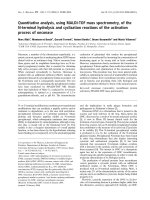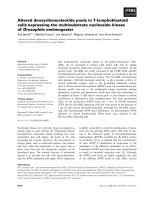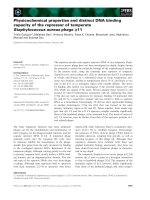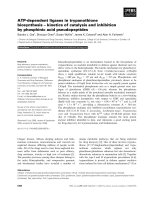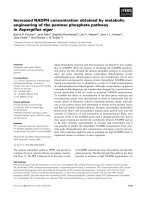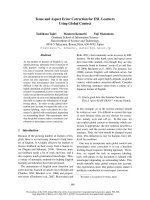Báo cáo khoa học: "PARASESSION ON TOPICS IN INYEZRACIXVE DISCOURSE INFLUENCE OF THE PROBLEM CONTEXT*" potx
Bạn đang xem bản rút gọn của tài liệu. Xem và tải ngay bản đầy đủ của tài liệu tại đây (236.42 KB, 4 trang )
PARASESSION ON TOPICS IN INYEZRACIXVE DISCOURSE
INFLUENCE OF THE PROBLEM CONTEXT*
Ar,avind
K. Joshi
Department of Computer and Infornmtion Science
Room 268 Moore School
University of Pennsylvania
Philadelphia, PA 19104
My consents are organized within the framework suggested
by the Panel Chair, Barbara Grosz, which I find very
appropriate. All of my conlnents pertain to the various
issues raised by her; however, wherever possible I will
discuss these issues more in the context of the "infor-
mation seeking" interaction and the data base doma/n.
The primary question is how the purpose of the inter-
action or "the problem context" affects what is said
and how it is interpreted. The ~ separate aspects
of this question that must be considered are the func-
tion and the domain of the discourse.
I. Types of interactions (functions) :
i. 1 We are concerned here about a computer system par-
ticipating in a restricted kind of dialogue
with
a
person. A partial classification of some existing
interactive systems, as suggested by Grosz, is as
follows. I have r~_named the third type in a somewhat
more general fashion.
Paz-ticipant Pl Participant P2
(Computer system) (Person)
Type A Expert Apprentice
Type B
Tutor
Student
Type
C Information Information
provider seeker
(some sor~c of large
and con~lex data base
or knowledge base)
Each type subsumes a variety of subtypes. For
example, in type C, subtypes arise depending on the
kind of infoz~ation ava~l~hle and the type of the user.
(More on this later when we discuss the interaction
of constraints on function and domain).
I. 2 It should be noted also that these differ~_nt types
are not r~ally completely independent; inf~tion
seeking (Type C) is often done by the ap~tice (Type
A) and student (Type B), and some of the expla/ning
done by t-utor~ (Type B) is also involved in the Type
C interaction, for exa~le, when P1 is trying to ex-
plain to P2 the st-ruc%%u~e of the data base.
1.3 The roles of the two par~cicipants are_ also not
fixed completely. In the type C interaction, some-
times P2 paz~ly plays the role of an ex~ (or at
least appears to do so) believing that his/her ex~
advice may help the system answer the question more
'easily' or 'efficiently'. For example l, in a pollu-
tion data base P1 may ask: Has company A dumped any
,~Bstes last week? and follow up with advice:
arsenic first. In ~ expert-apprentice interactlon,
the e xper~c's advice is assumed to be useful by the
apprentice. In the data base domain it is not clear
whether the 'expert' advice provided by the user is
always useful. It does however provide infor~ration
about the user which can be helpful in presenting the
response in an appropriate manner; for example, if
arsenic indeed was one of the wastes dumped, -~hen, per-
haps, it should be lis:ed first.
1.4 The interactions of the type we are concerned about
here are all
meant
to aid a person in some fashion.
Hence, a general characterization of all these t~/pes is
a helping function. However, it is useful to distin-
guish the types depending on whether an information
or information sharin~ interaction zs involved.
C interaction is przmarily information seeking,
although some sharing interaction is involved also.
This is so because information sharing facilitates in-
formation seeking, for example 2 , when Pl explains the
structure of the data base to P2, so that P2 can engage
in infor~nation seeking more effectively. Type A and
B are more information sharing than infornmtion seeking
interactions.
i. S Another useful distinction is that type C interac-
tion has more of a service function than types A and B
which have more of ~ining function. Training in-
volves more of information sharing, while service in-
volves more of providing infornmtion requested by the
user.
2.
Information about
the
user:
2 .i By user we usually mean user type and nor a spe-
cific user. User inforr~ation is essential in deter-
minJ_ng expectations on the par~ of the user and the
needs of the user. Within each type of interaction
there can be many user types and the same infoz~nation
may be needed by these different types of users for
different reasons. For exan~le, in t-/pe C interaction,
pr~_r~gist-ration iIlfor~ation about a course scheduled
fox" the foz~chcoming t~ may be of interest to an in-
st-cuctor because he/she wants to find out how popular
his/her course is. On the other hand, the same data
is useful to the regisrrer for deciding on a suitable
r~x)m assigr~nent. The data base system will often pro-
vide different views of the same data to different user
types.
2.2 In general, knowledge about the user is necessar~,
at leas~ in the type C interaction in order to decide
(i) how to present the requested information,
(ii) what additional information, beyond that ex-
plicitly requested, might be usefully pr~esented
(this aspect is not independent of (i) above),
(iii) what kind of responses the system should provide
when the user's misconceptions about the domain
* This work was par~ially supported by the NSF grant
MCS79-08401.
I ,~Bnt to thank Eric Mays, Kathy McKeown, and Bonnie
Webber for their valuable conments on an earlier draft
of this paper.
31
(i.e., both The ~crure and content of the
data base, in short, what can be talked about)
are detected.
(More about this in Section 5).
3. Conversational style:
3.1 In the type C interaction, The user utterances (more
precisely, user's Typewritten input) are a series of
questions separated by the system's responses. By and
large, the system responds to the current question.
However, knowledge about the preceding interaction i.e.,
discourse context (besides, of course, the information
about the user) is essential for tracking the "topic"
and thereby deter~nining the "focus" in the current
question. This is especially importa~nz for derer~Iining
how to present the answer as well as how to provide
appropriate responses, when user's misconceptions are
detected.
Type A and B interactions perhaps involve a much more
structured dialogue where the sZru:rure has its scope
over much wider stretches of discourse as co~d to
the ai@]ogues in the Type C interactions, which appear
to be less strucru~.
3.2 The type of interaction involved certainly affects
the conversational style; however, li%-tle is known
about conversational style in interactive man/machine
communication. Folklore has it that users adapt very
rapidly to the system's capabilities. It might be
useful to compare this situation to that of a person
talking to a foreigner. It has been claimed that
natives talking to foreigners deliberately change their
conversational style = (for example, slowing down their
speech, using single words, repeating certain words,
end even occasionally adopting some of the foreigner's
style, etc. ). It may be that users rr~-at the computer
system as an expert with respect to the knowledge of
the domain but lacking in some communicative skills,
much like a native talking to a foreigner.
Perhaps it is misleading to Treat man/machine interact-
ive discourse as just (hopefully better and better)
approximations to h~ conversational interactions.
No matter how sophisticated these systems become, they
will at the ve.~y least lack the face to face interac-
tion. It may be That there are certain aspects of
these interactions that are peculiar to This modaliry
and will always rema/m so. We seem to know so little
about these aspects. These remarks, perhaps, belong
.more to the scope of the panel on social context than to
the scope of this panel on the problem context.
4. Relation of expectations and functions:
~.i In the information seeking interaction, us,~11y,
the imperative force of the user's questions is to have
the system bring it about that The use~- comes to know
whatever he/she is asking foP. Thus in asking the
question Who is r~istered in CIS 591? the user is in-
terested in knowing who is registered in CIS 591. The
user is normally not interested in how the syst~n got
the answer. Ln the Type A and B in actions the
imperative force of a question from the user (apprentice
or student) can either be the same as before or it can
have the imperative force of making the system show the
user how the answer was obtained by the system.
4.2 ~.n the data base domain, although, primarily the
user is interested in what the answer is and no~ in how
it wa obtained, this need not be the case always.
Somet ~s the user would like to have the answer accom-
panied by how it was obtained, the 'access paths'
through the ~ta base, for example.
4.3 Even when only the what answer is expected, often
the presentation of the answer has to be accompanied by
some 'supportive' information to make the response use-
ful to the user 4 . For exa~le, along with the student
name, his/her department or whether he/she is a Eradua1~
or under~duate student would have to be stated. If
telephone numbers of students are requested then along
with the telephone numbers, the corre_sponding names of
students will have to be provided.
S. Shared knowledge and beliefs:
5.! The shared beliefs and goals are embodied in the
system's knowledge of the user (i.e., a user model).
It is important to assume that not only the system has
the knowledge of the user but that the user assumes
that the system has this knowledge. This is very
necessary to generate appropriate cooperative responses
and their being correctly understood as such by the
user. In or~ina_-y conversations this type of knowiec~e
could lead to an infinite regmess and hence, the need
to require the shared knowledge to be ',u/rual knowle~e'.
However, in the current da~a base systems (and even in
the expert-epvrentice and tutor-student interactions)
I am not aware of situations that truly lead to some of
the well krK~an prDblems about 'mutual knowledge'
5.2 As regards the knowledge of the data base itself
(both structure and content), the system, of course,
has this knowledge. However, it is not necessary
that the user has this knowledge. In fact very often
the user's view of The data base will be different
from the system's view. For large and complex data
bases this is more likely to be the case. The system
has to be able to discern the user's view and present
the answers, keeping in mind the user's view, ~Tuile
insuring that his/her view is consistent with the
system's view.
S. 3 When the system recognizes some disparity between
its view and the user's view, it has to provide appro-
priate corrective responses. Users' misconceptions
could be either extensional (i.e., about the content
of the data base) or intensional (i.e., about the
structure of the data base) ~ . Note that the ex-
tensional/inTensional distinction is from the point
of view of the system. The user may not have made
the distinction in that way. Some simple examples of
corrective r~_sponses are as follows. A user's ques-
tion: Who took CIS 591 in Fall 19797 presumes that
CIS 591 was offered in Fall 1979. If ~his ~as not
the case then a response None by the system would be
misleading; rather the response should be that CIS 591
was not offered in Fall 1979. This is an instance of
an extensional failure. An example of intensional
failure is as follows. A user's question: How man 7
under~aduates taught courses in Fall 19797 pr~su~es
(among other things) that undergraduates do teach
courses. This is an intensional presumption. If it
is false then once again an answer None would be mis-
leading; rather the response should ~ that under ~
graduates are nor perm ~Ted to teach coUrSes, faculty
members teach courses, and graduate students teach
courses. The exact nature of this response depends
on the s~:rucrure of the data base.
5. Co~lexir~ of The domain:
6 .i Iu each type of interaction the complexity of the
interaction depends both on the nature of the interac-
tion (i.e., function) as well as the domain. In many
ways the complexity of the interaction ultimately seems
to depend on the cc~nplexity of the domain. If the
task itself is not very complex (for example, boiling
water for tea instead of assembling a pump) the task
oriented expert-apprentice interaction cannot be very
complex. On the other hand data base interaction
which appear to be simple at first sight become in-
creasingly complex when we begin to consider (i) dyna-
mic data bases (i.e., they can be updated) and the
associated problems of monitoring events (ii) data
bases with n~itiple views of data, (iii) questions
whose answers z~equiz~ the system to make fairly deep
inferences and involve computations on the data base
i.e., the answers are not obtained by a straigbtfor%mz~
retrieval process, etc.
NOTES:
i. As in the PLIDIS system described by Genevieve
2. As in Kathy McKeown's current work on gene_~ating
descriptions and explanations about data base
st-~ucrure.
3.
For exa~le, by R. Rammurri in hem talk on
'Strategies involved in talking to a foreigner'
at the Penn Linguistics Forth 1980 (published in
Penn Review of Linguistics, Vol. 4, 1980).
~. Many of my comments about supportive information
and corrective responses when misconceptions about
the ccntent and the stTucrure of the data base
are detected are based on the work of Jerry
Kaplan and Eric Mays.



